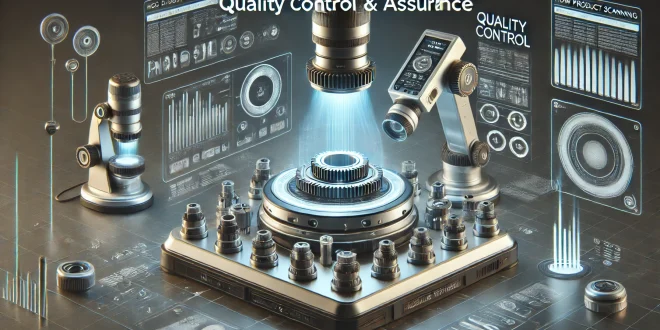Maintaining strict quality control (QC) and quality assurance (QA) criteria is vital in the fast-paced manufacturing sector. These procedures can be much improved by including cutting-edge technologies like 3D product scanning.
This creative strategy lets businesses cut expenses, increase accuracy, and boost the dependability of products. Using 3D scanning helps producers quickly find flaws and guarantee that items satisfy exact criteria, therefore guaranteeing more uniform quality.
Moreover, this technology simplifies the inspection process, therefore allowing faster turn-around times and improved resource allocation. We will discuss the several ways 3D scanning can transform manufacturing sector quality control and quality assurance processes, promoting efficiency and perfection in the end.
What Is 3D Product Scanning?
Using several technologies, 3D product scanning captures the form, size, and surface details of an object so changing physical objects into exact digital 3D models for thorough investigation and examination.
Among the popular techniques, laser scanning gathers precise measurements using laser beams to create detailed point clouds fit for 3D product modeling creation. Structured light scanning projects particular light patterns onto an item, therefore capturing the ensuing distortions to provide a three-dimensional depiction.
Though usually at a slower speed than other methods, contact scanning provides great precision by physically touching the object to get data. Every scanning technique has unique benefits that qualify them for different manufacturing uses.
The Function of Assurance and Control of Quality
Any manufacturing process depends on quality assurance and control as fundamental elements.
Defining QC and QA
- Quality Control (QC): Quality control (QC) is the operational methodologies and actions applied to meet criteria for quality. Quality control is mostly concerned with spotting flaws in completed goods.
- Quality Assurance (QA): Quality assurance, or QA, is the methodical procedures and practices meant to guarantee that the goods satisfy given criteria and standards.
Value of Quality Assurance and Control
Maintaining good product quality presents different difficulties for manufacturers. Among these are several:
- Production process variations.
- Variations in supplier quality.
- Changing consumer expectations.
Reducing faults, raising customer happiness, and keeping a competitive advantage all depend on strong QC and QA policies being followed.
Applications of 3D Scanning for Quality Control
Beyond simple quality control, 3D scanning has a great influence on quality assurance.
Better Product Consistency
3D scanning helps to provide more homogeneity in the manufacture of products. Good measurements and careful analysis enable manufacturers to maintain batch uniformity. To meet consumer expectations calls for this consistency.
Lowering of Costs and Inspection Times
Moreover, businesses that make use of 3D scanning usually pay less for inspections and have shorter durations. Conventional inspection techniques can demand time and effort. 3D scanning can enable businesses to save time and money by automating many of these tasks.
Improved Traceability and Documentation
3D scanning makes documentation easier. For audits and industry standard compliance, the digital models created offer thorough records of product characteristics which can be rather important. In controlled sectors such as aircraft and medicines, this traceability is particularly crucial.
Encouragement of Industry Standards Compliance
Finally, 3D scanning allows manufacturers to guarantee their goods follow industry standards. The thorough information gathered can be very helpful in verifying that goods satisfy all necessary criteria, thereby preventing expensive fines and damage to reputation.
Including 3D Scanning Into Current Methodologies
Including 3D scanning in current production calls for careful preparation. Starting with your present quality control (QC) and quality assurance (QA) systems, identify areas that can use improvement. Once you have a firm grasp, choose the appropriate 3D scanning technology fit for your particular needs and financial limits.
Your employees must receive thorough instruction so they may be competent in using the new technologies. Pilot tests help you to improve the procedures and handle any potential problems before committing to a complete-scale deployment.
Effective implementation also depends on making appropriate tool and software investments. Choose scanning tools fit for your sector of business, such as slot machine software development, and programs capable of effectively managing data processing and analysis.
This method improves general production and quality in your manufacturing processes in addition to simplifying 3D scanning integration. Following these guidelines will help you to utilize the advantages of this creative technology and guarantee a better transition.
Emerging Patterns in 3D Scanning and Quality Control
The powers of 3D scanning change along with technology. Emerging technologies like artificial intelligence and machine learning are progressively impacting this discipline since they allow the study of scanned data to find possible flaws before they start. This development greatly simplifies procedures of quality control.
Future directions of quality control (QC) and quality assurance (QA) are projected to be more data-driven. Advanced analytics technologies are probably going to be adopted by businesses to get insightful analysis from the massive amounts of 3D scanned data.
This change will not only raise productivity but also guarantee better quality of products. Early adopters of 3D scanning will probably have a competitive edge as this technology becomes more and more popular. Rising customer demand for premium goods will force businesses to keep innovating and improving their QC and QA procedures.
All things considered, the combination of 3D scanning with innovative technology is poised to transform manufacturing and quality control, therefore producing better goods and more effective processes going forward.
Conclusion
All things considered, 3D product scanning offers many benefits that might greatly improve quality assurance (QA) and quality control (QC) in manufacturing. Using accurate measurements, real-time data, and improved documentation this technology helps manufacturers not only meet but exceed consumer expectations.
Including 3D scanning in their quality control and quality assurance procedures helps companies to take a proactive strategy that increases product quality and stimulates efficiency and creativity. Manufacturing results can show significant improvement from this forward-looking approach. We urge you to contact us if you wish to improve your quality control procedures utilizing 3D scanning.
Together, we can investigate how this innovative technology might change your approach to quality, therefore enabling you to stay competitive in the market and provide exceptional results. Adopting 3D scanning might revolutionize your manufacturing processes and open fresh opportunities for client happiness and excellence. Don’t let the chance to elevate your quality assurance pass by.
 Diverse Perspectives: Insights & Stories Exploring Ideas, Sharing Knowledge
Diverse Perspectives: Insights & Stories Exploring Ideas, Sharing Knowledge





